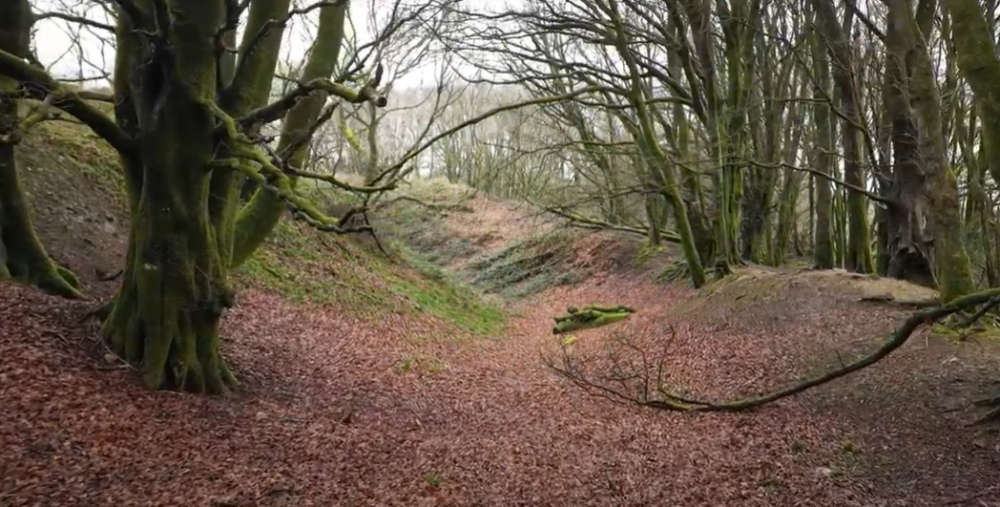
The prehistoric monument, near Honiton, is one of Devon’s most spectacular examples of an Iron Age fortification and is positioned on a prominent spur of the Blackdown Hills. The Devon Archaeological Society aims to manage the site for its nature conservation as well as for its archaeological significance.
Hembury Hillfort’s future as a publicly accessible landmark has been secured following its purchase by The Devon Archaeological Society (DAS).
Now the DAS aims to manage the site for its nature conservation as well as for its archaeological significance and will work with us, the Devon Wildlife Trust and the Blackdown Hills AONB Partnership to achieve this.
The prehistoric monument, near Honiton, is one of Devon’s most spectacular examples of an Iron Age fortification and is positioned on a prominent spur of the Blackdown Hills.
Its massive earthen ramparts and ditches date from the mid-first millennium BC and they create a prominent landmark with commanding views over the surrounding countryside.
Hembury Hill ramparts
DAS purchased the site with some of its own funds, alongside substantial donations from some of its Trustees and members, and with a £73,047 grant from Historic England.
When the hillfort was put up for sale on the open market in 2021, the most desirable outcome was that this nationally important site should come into the ownership of a suitable conservation body to secure its long-term management and enable public access.
DAS Trustees, project partners and neighbours celebrated the purchase at an event at the hillfort last week.
Hembury Hillfort survives in an exceptionally good condition. Its massive defences are well-defined and form a complete circuit. It offers valuable evidence about the lives, economy and landscape of Neolithic and Iron Age communities and the Roman military occupation of the South West.
The DAS hopes to manage the site for its nature conservation as well as for its archaeological significance, and to this end has recently signed a Memorandum of Understanding with the Devon Wildlife Trust with a view to securing joint management.
The DAS will work with Devon County Council, the Devon Wildlife Trust and the Blackdown Hills AONB Partnership to achieve this.
Bill Horner, Devon County Council’s County Archaeologist and President of the Devon Archaeological Society said:
“Our Society is delighted to be able to secure the long-term protection of this magnificent site for both its history and its wildlife.
“The site is much valued by local people who use it as a place for quiet enjoyment. We are looking forward to working with our new neighbours and the wider local community to continue to care for this splendid monument, so that the future of Hembury can be ensured for future generations.”
The purchase is the culmination of nearly 100 years of the DAS’s close association with the hillfort, from early excavation to ongoing survey and site management.
The Society was founded in 1928, and its very first excavations were at Hembury the following year. These continued until 1935, directed by the pioneering archaeologist Miss Liddell (1890–1938). They revealed the long and fascinating story of the hillfort.
Dr Eileen Wilkes, Chair of the Society, said
“Our Society has been closely involved with the archaeology of this very special site for almost 100 years. Hembury played an important part in the development of archaeology in the 1930s, and recently archaeologists have been able to build on that pioneering work. We intend to continue the programme of research, as Hembury still has much to tell us.”
Historic England has recently awarded £15,000 for a three-year management agreement for the site. The funding is to support the DAS in carrying out regular maintenance of the hillfort, including managing vegetation, which can damage archaeological deposits, and maintaining a healthy grass cover.
Duncan Wilson, Chief Executive of Historic England said:
“Hembury Hill is a very special place, combining natural beauty and historic significance. You can still stand on its Iron Age ramparts today and look out over the surrounding countryside, much as our ancestors would have done over two thousand years ago. Historic England is delighted to have played a part in securing its future.”
Hembury Hillfort is open to visitors using public rights of way, as long as they respect its archaeological and nature conservation importance.
Hembury Fort, Payhembury, Devon. The monument includes Hembury Fort, a small multivallate hillfort of Iron Age date which occupies the site of an earlier Neolithic causewayed enclosure. The location of the hillfort, on a narrow south facing promontory at the end of a 240m high ridge protruding from the Blackdown Hills, was almost certainly chosen for its natural defensive qualities and its extensive views over the Otter River valley and the surrounding countryside.
Excavations revealed that occupation began in the early Neolithic (New Stone Age), nearly 6,000 years ago. Two interrupted circuits of banks and ditches, a ‘causewayed enclosure’, separated the southernmost tip from the rest of the spur. This may have been used for social and ceremonial gatherings by one of Devon’s earliest farming communities. Recent dating work by Cardiff University has put the earliest use of the site at about 3700 BC.
The earthworks that can be seen today date from the Middle Iron Age (about the 3rd Century BC) but overlie an earlier Iron Age defensive circuit.
The Society’s excavations, and more recent geophysical survey undertaken by Dr Wilkes of Bournemouth University, shed new light on the Neolithic structure of the hillfort and showed that the interior contained circular houses and other structures, typical of the Iron Age. The finds from the Society’s excavations are looked after by the Royal Albert Memorial Museum in Exeter, where many of them can be seen on display.
Excavations by Professor Malcom Todd in the 1980s confirmed more of the hillfort’s complex past. During the conquest of the South West in the 50s AD, this strong defensive position was re-occupied by the Roman army for a short period of time, before they established a longer-lived fortification just west of present-day Honiton.
Hembury is a nationally important archaeological site and is protected as a Scheduled Monument. It is a ‘multivallate’ Iron Age hillfort, a rare type of monument of which there are only around 100 examples recorded in England. It is vitally important to understanding the nature of settlement and social organisation in the Iron Age period, and of major importance to Neolithic studies.
Historic England and the DAS, along with many partners and dedicated volunteers, have been involved in the management of Hembury Hillfort for many years.
In 2008 Hembury was in poor condition with limited access, and it was added to Historic England’s Heritage at Risk register. Following this, a Countryside Stewardship Scheme was agreed for the site, which secured funding from Natural England to support management works at the hillfort. Historic England also funded conservation works and other improvements, including new signage.
The Society and Bournemouth University carried out a geophysical survey of the entire interior of the monument in 2016 with funding from Devon County Council to inform decisions about the site’s future management, and this also produced important new information about the hillfort’s history.
Following years of careful conservation, Hembury Hillfort was removed from the Heritage at Risk register in 2018. The Society continues to organise working parties to control scrub growth as well as carrying out archaeological fieldwork.

 Criminal investigation into suspended Chief Constable dropped
Criminal investigation into suspended Chief Constable dropped
 Devon families receive their primary school place offers
Devon families receive their primary school place offers
 Theft of Quad Bike / Livestock Trailer and / Farm Tools - Tiverton and Withleigh Area
Theft of Quad Bike / Livestock Trailer and / Farm Tools - Tiverton and Withleigh Area
 Stay vigilant for ticket fraud ahead of top events and concerts this summer.
Stay vigilant for ticket fraud ahead of top events and concerts this summer.











